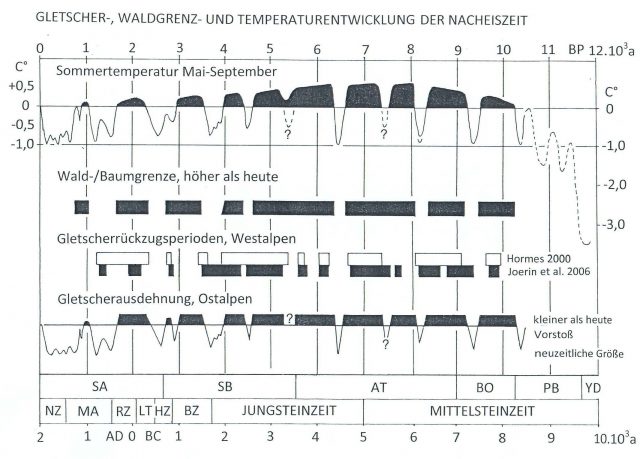By P Gosselin on 25. January 2020
“Glaciers: climate witnesses of the ice age to the present”. A book review
By Horst-Joachim Lüdecke and Klaus-Eckart Puls
Hat-tip: Die kalte Sonne
(Translated by P. Gosselin
Prof. Gernot Patzelt is an internationally renowned glaciologist with numerous publications and lectures. Now he has, as it were, presented his life’s work with the book “Gletscher: Klimazeugen von der Eiszeit bis zur Gegenwart“ (Glaciers: Climate Witnesses from the Ice Age to the Present” (Hatje Cantz-Verlag, Berlin, 2019, 266 pages). It combines the overwhelming artistic aesthetics of Alpine glaciers in painting with scientific glaciology.

Gernot Patzelt, Professor of High Altitude Research at the University of Innsbruck and Head of the Alpine Research Centre Obergurgl in Tyrol, was not and is not retired after his retirement in 2004. His lectures, especially those at EIKE climate conferences (here, here) and his writings, which are listed here, bear witness to this. He was also co-author of the book “A. Fischer und G. Patzelt: Gletscher im Wandel: 125 Jahre Gletscher-Meßdienst des Alpenvereins, Springer, 2018″.
His book “Klimazeugen von der Eiszeit bis zur Gegenwart” (Climate Witnesses from the Ice Age to the Present), which is discussed here, breaks new ground by making the otherwise rarely attempted connection between natural aesthetics and scientific description. The Austrian glaciologist has convincingly succeeded in this attempt, namely the connection of painting history with Ice Age history, glacier history, landscape history, vegetation history, climate history, cultural history … and more!
Almost the entire first half of the book is dedicated to the representation of glaciers in painting. The images by Thomas Ender and Ferdinand Runk, chamber painter to Archduke Johann of Austria (here), are shown here, and thus movingly beautiful paintings have been rescued from oblivion.
In addition to aesthetics, however, science is also not neglected in this first part of the book. In the chapter “The glaciological significance of the paintings” it is explained how the glaciers in question can be viewed from the paintings. Thus the paintings shown are at the same time scientific documents.
70% of last 10,000 years saw smaller glacier extent
In the second part of the book a wealth of details is given on different regions, altitudes and many individual glaciers. One learns the fact that today’s climate, vegetation and glacier situation is nothing “special” caused by industrial man, but is well within the “climate noise” of the last ten thousand years!
Moreover, a summary graph from the book on page 238 shows: For about 70% of the last 10,000 years (post-glacial period), the extent of the Alpine glaciers was smaller than today, while tree lines and temperatures were higher as well.
Patzelt summarizes (on p. 235):
“Around 8500 BC (before Christ) the temperatures were lower, from 8200 BC they were already above the level of the present temperature conditions … the postglacial warm period reached a first peak shortly after 6000 BC, followed by a second peak around 4200 BC. During this time … the timberline was 100-130 meters higher than what is currently possible, which means that a summer temperature of 0.6-0.8 °C higher can be derived:
“The temperature increase of recent decades (note: 1980-2010) is within the postglacial range.”

Figure 1: Summer temperature, forest-/treeline, glacial retrest periods Westalpen, glacier advance Ostalpen, chart from p. 238 of the above mentioned book by G. Patzelt.
From the book, but also from the biography of Gernot Patzelt (here), the primary closeness to nature in his research work cannot be overlooked. His own exploration, hiking and the collection of scientifically interesting tree relics on site, as melting glaciers release them again and again, were his main and heart’s desire.
Only after that did his desk and laboratory follow. You can feel his love for the scientific subject and, inseparably connected with it, his never-ending admiration of the beauty of glaciers.
We wish his book every success, because there is hardly anything comparable to this object. And we are looking forward to welcoming Gernot Patzelt once again to give a lecture at future EIKE Climate Conferences.
—
This articles first appeared at EIKE.


